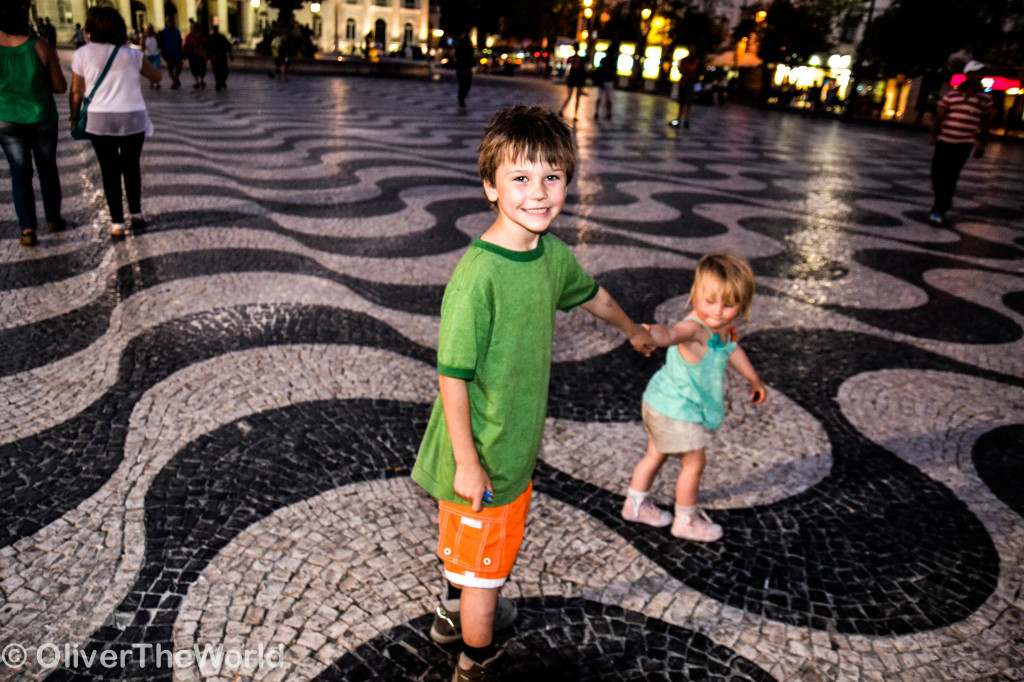June 25 – July 7
Lisbon, Portugal
It’s been a while since my last post, but I can admit to having a pretty qualified excuse. For the past two weeks, we’ve made our home the ancient and decadently crumbling neighborhood of Alfama; Lisbon’s historic and, in many ways, cultural heart. In an attempt to align ourselves with the locals, we went Internet AWOL for a while and instead made every effort to suspend ourselves in the ether of what has been the most charismatic urban atmosphere we’ve encountered while traveling in Europe over the past eleven months.
The allure of Lisbon, for us, was the sense of being both tourist and local. Every day, we were as likely to stagger up the stairway streets (escadinhas, literally “ladders”) alongside romper and flip-flop-clad tourists as a stooped grandmother on her way home from the local feira (market). To break the back of the endlessly scorching Lisbon afternoons, we ferreted out little joints that gave us the best price on a pingado gelado (like a macchiato served alongside a glass of ice) and Portugal’s signature delicious meat snack: a bifana (grilled pork cutlet on a roll). We sorted out the fastest walking routes (with the best views over the city to boot) through alleyways between Barrio Alto and Chiado. We noted the differences between Spanish and Portuguese bullfights while attending one at Campo Pequeno (the Portuguese frequently put the bulls out in the pasture to stud after a good fight and the primary objective of the bullfighter is essentially to be gored, which is more unbelievable in real life than I can possibly describe). Truly, after two weeks, there has been so much we fell in love with here in Portugal’s capital and even some things that made us cringe, so I felt it would be best if we all shared what affected us the most.
Emily: After a rainy, chilly month of May spent in Northern Spain and Portugal, Lisbon brought us the first of the summer’s heat. Every other night, I hung our laundry out on the line where it would dry in hours. With all the wash we’d accumulated in nearly three straight weeks of transit, it became like a ritual to me. A glass of vinho verde, a bucket of clothespins, and the breeze blowing across the River Tejo. The rhythm of my evenings were dictated by the bells of the Igreja de São Vicente de Fora. The church’s twin pearly white steeples, city icons in their own right, rose up just in front of our kitchen terrace and kept time every thirty minutes. Some nights, a fadista’s voice from the restaurants below wafted up from the tangled warren of Alfama’s travessas (alleyways) to our second story balcony. After the kids were in bed, Ryan and I would lean out over the railing, our faces aglow in the light reflected from São Vicente, and we would just listen to the singers’ soulful fado lyrics as they were woven together with the accompanying Portuguese guitar. 
I also loved how, at the end of a particularly hot day, the dusk settles over Lisbon in just such a way. A pink tinge forms a filmy layer over and between the staggered white-washed walls and red-tiled roofs of the old city and swallows wheel in jilted circles above us before returning to the eaves of abandoned buildings. The river echoes the blue of 18th century azulejo (hand-painted tiles) panels offsetting our little plaza, and in the little street below an old man stirs the embers smoldering in an old, rusty, halved oil drum before laying a trio of salted sardines on the makeshift grill. I don’t know how to say it better…but it is so achingly summertime here in this city.
Of course the heat worked against us some of the time. Lisbon is a city for those who go on foot, and while Alfama was home to us, it put us in a situation where our primary mode of transport was our own two legs. We walked the long stretch of waterfront all the way to the Praça de Figuera more than once in a sweltering 96°, and we have the sunburns to prove it. But that experience leads me to Ryan’s hit list…
Ryan: The tram. From the moment we climbed aboard the old, creaky wooden 28 and rode it full circuit from Graça to the Basílica Estrela, we knew the city in a unique and more intimate way. In Alfama near our apartment, we were always casting eyes over our shoulder and keeping our ears alert to the telltale sound of grinding brakes as we crossed the street at Escolas Gerais where the tram makes its narrowest (and most harrowing) ascent up to the Miradouro da Senhora do Monte. There are seven brutal hills in Lisbon, and for €2.80 per person, the price was worth it!
I also fell in love with the city’s festive atmosphere. Maybe it’s because we landed in Lisbon at the beginning of their official summer (June), but it’s been one party after the next. The highlight was the raucous celebration of Lisbon’s patron saint. During the Festa do Santo António, every level surface in Alfama was converted to a communal dining area and locals served homemade sangria and sardinhas assadas (grilled sardines) to anyone who stopped. Another night we had the good fortune to stumble across a free fado concert held in front of the baroque Igreja São Roque in the neighborhood of Bairro Alto. Ana Moura’s sultry contralto nearly brought us to our knees.
Oliver: Our house looked right at the Larga Santa Marinha, a little plaza with just enough surface area for him to learn how to ride his bike. After four evenings and a tremendous amount of effort on behalf of his father and several local alfacinhas (locals) cum cheerleaders, Oliver was maintaining his balance and executing turns like a pro. And, according to him, the little plaza “was also a great place to kick a soccer ball without it rolling down the big hill”.
And what does a five year old complain about in a city like Lisbon? The streets themselves. For a little guy with two left feet to begin with, the calçada portuguesa is an accident waiting to happen. The sidewalks, plazas, and in some cases the streets in Lisbon are paved with innumerable blocks of chiseled black basalt and white limestone that form intricate mosaics. While timelessly beautiful (in the evenings they glow under the lamplight), the surface of the pavers have become polished with time and use to the point of being downright slippery. Furthermore, out-of-place stones frequently jut out haphazardly and threaten to trip even the sturdiest pedestrians. More than once, Ollie’s loping stride lost it on the calçadas, and he was sent flying into the gutter.
Kendley: Wherever we wandered, from the Tower in Bélem to the manicured gardens in Parque Eduardo VII, the girl always found an excuse for an ice cream break. The telltale signage outside the doors of countless local cafes advertised the day’s selections, and with her squeaky little “Olá” and a couple of blown kisses, the shopkeepers would practically dive into their freezers at her command.
Other Highlights:
Museo Nacional do Azulejo (National Tile Museum)
Mosteiro dos Jerónimos (located in Bélem)
Feira da Ladra (Thieve’s Market in Alfama)
Oceanário (aquarium)
Igreja de São Roque (located in Bairro Alto)
National Pantheon (located in Alfama)
Palácio Nacional da Pena (located in Sintra)








Your posts always bring me to the verge of tears.
Such joy and such aliveness.
I smile with my entire being and thank you both for the
thoughtful and vivid string of pearls you are gifting us with your stories and impressions.
xoxoAuntC
A Celia, thank you for your beautiful words. You truly are with us every day, every step of our journey. Lots of love to our fellow wandering soul. Someday we hope to find you out there!